Related sites:
Newsletter: Perspectives on Power Platform
Company: Niiranen Advisory Oy

In 2020 Release Wave 1, Microsoft is shipping new App Modules for Sales Team Member and Customer Service Team Member. Let's look at the Early Access features and see what you can do with these apps, prior to the coming technical enforcement of Team Member access rights.
In the 2020 Release Wave 1 release plan documentation we saw that Microsoft is finally going to bring technical licensing enforcement for Dynamics 365 Team Members into the platform. By launching specific App Modules designed to be used with the cheap Team Member license as well as building the mechanism for controlling which Service Plan entitles the users to access which App Modules, there will now be a clear line for what is and isn’t possible right within the system.
That’s how it is in theory. What about in practice? Let’s explore the Early Access features launched for 2020 Release Wave 1 on February 3rd and see how these App Modules are implemented.
Since Sales is by far the most common business process that CRM systems built on Dynamics 365 Online are managing, let’s start from the dedicated Team Member App Module for this scenario. The pre-release documentation isn’t very extensive yet, but from there we can get the basic intention of this new app:
“At a high level, users with the Team Member license can perform the following tasks in the Sales Team Member app: 1) Customer management: work with accounts and contacts. 2) Lead and opportunity management: see leads or opportunities linked with accounts or contacts, or see other sales-related data. 3) Add activities, such as notes.”
Upon launching the app, we’re greeted with a familiar experience that looks like Dynamics 365 Sales, only it’s simplified to contain just 5 menu items in the sitemap: Activities, Accounts, Contacts, Leads, Opportunities. If the dashboards menu was also included here, the app would resemble the kind of CRM system that most small organizations or teams actually need in real life.
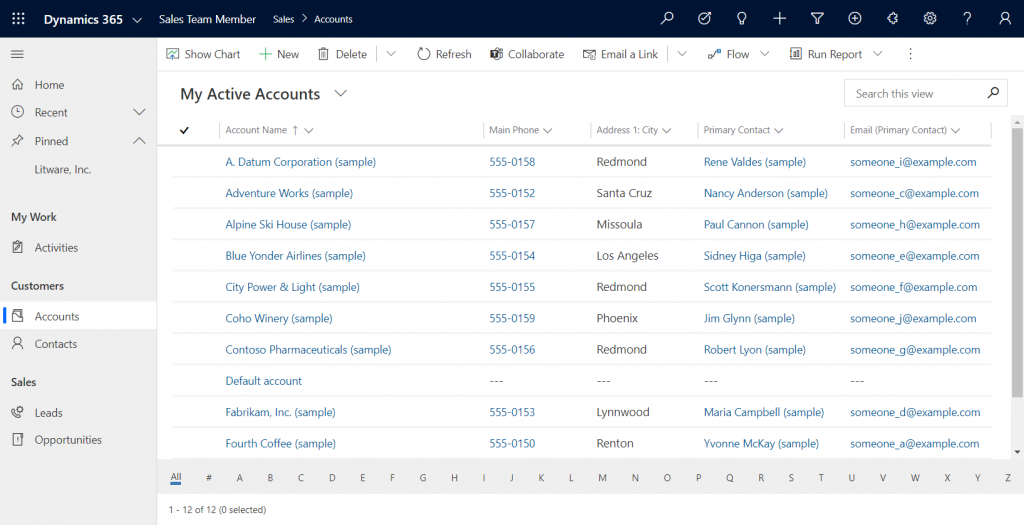
If we’re using the app with the full access rights granted by a powerful security role like system administrator then there isn’t much that the Sales Team Member app stops us from doing. For example, creating or editing accounts is one of the rights that has been stripped away from the Team Member license, yet the app would happily show us a “New” button for adding accounts via this App Module. The secret lies in the Sales Team Member security role that comes with the solution. A view of the privileges for core entities looks like this:

Wow, that’s quite restricted indeed! Assigning only this role the users wouldn’t even permit viewing activities from anyone else, nor leads, or adding contacts. Let’s get back to the customization options later, but this is indeed in line with the description of what Microsoft intended the offer with the standard Sales Team Member app.
The second experience is for Customer Service – but not in the way that you’d traditionally see the Customer Service App of Dynamics 365 being leveraged for assisting external customers. This Team Member app is intended for scenarios where the app users is actually the customer being served:
“With the entry-level Team Member license, you can now address self-service support scenarios for your employees using the new Customer Service Team Member app module. Employees can create cases for their problems, such as laptop issues, HR queries, and administrative needs, and interact with agents through the commenting feature. They can also search the knowledge base for solutions pertaining to their problems.”
Unlike the Sales Team Member App, this App Module isn’t installed by default. That’s probably a good thing, since I’d imagine the majority of Dynamics 365 customers are not using it as an internal helpdesk – although it definitely is a perfectly sensible scenario. If that’s what you’re doing, then the CS Team Member solution installation will need to be started from the Dynamics 365 Admin Center.
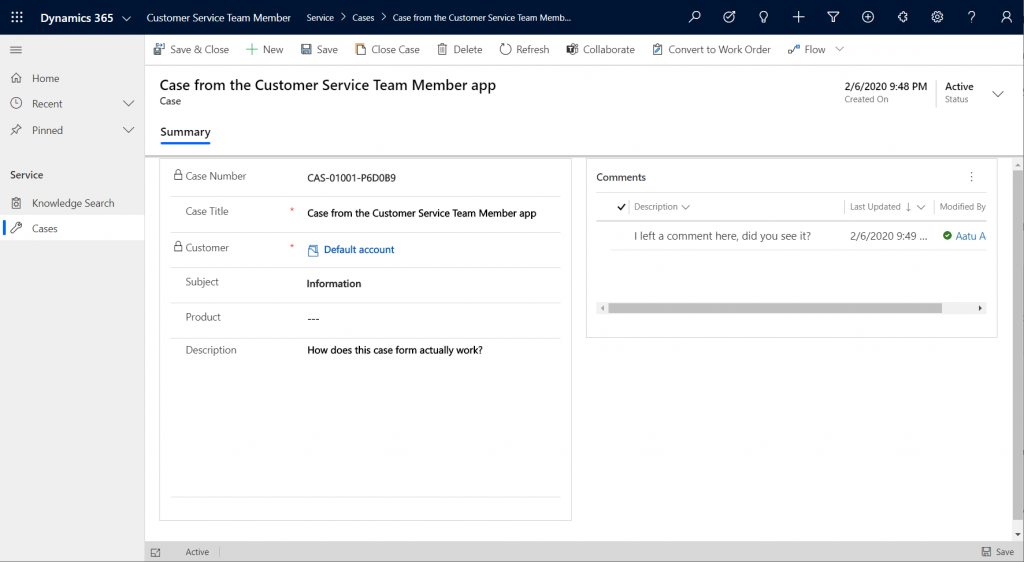
If we look at the same case record via the full form in the Customer Service Hub App Module, we’ll see quite a stark difference. The solution package for the Team Member app appears to contain a web resource called Incident_teammember_library.js that modifies the behavior of the case form in many ways, such as hiding the Business Process Flow, replacing the standard Resolve Case dialog with a much more streamlined version and who knows what else. The Command Bar also contains far less functionality than it normally would.
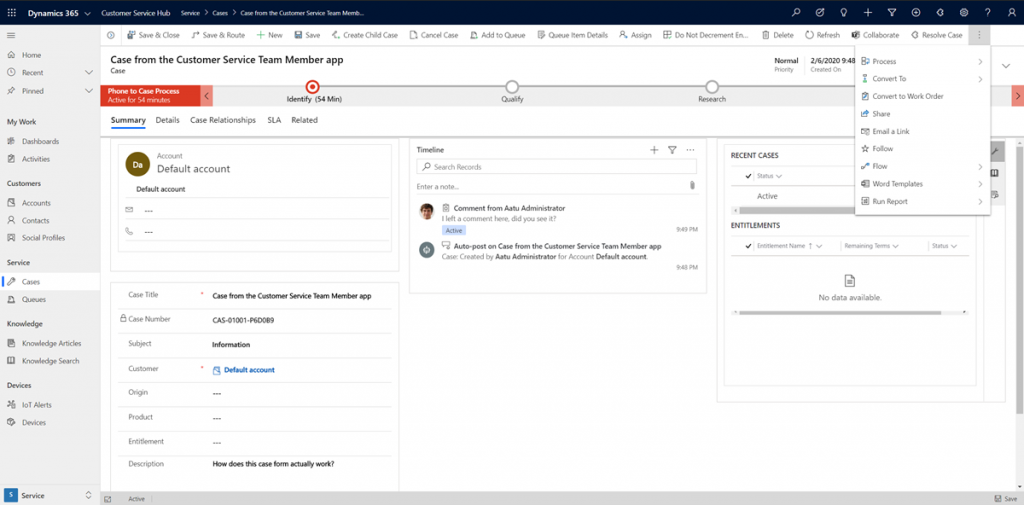
An interesting feature of the Customer Service Team Member app is the use of a default account that you can configure for the organization. The cases created via the Team Member app will automatically be linked to this account as the customer. The requirement for having either an account or contact as the customer has been a part of the MS CRM data model since day one, which has traditionally made the internal helpdesk scenarios quite tricky to implement – if the customers actually are users of Dynamics 365. Without any further documentation, I’m not quite sure what Microsoft’s vision has been for this new feature in the Customer Service Team Member app, since it looks like there isn’t any linkage to the internal customer (user) now in the case data model. If a person who provides helpdesk services would now assign the case to himself to work on, where’s the reference to the actual person who was in need of assistance?
The other available menu in the Team Member app sitemap, Knowledge Search, isn’t a reference to any entity but rather presents a dedicated UI for browsing published Knowledge Articles. Well, browsing isn’t maybe the right term, since the only option here is free text search for keywords, which will then return a list of articles if matches are found.
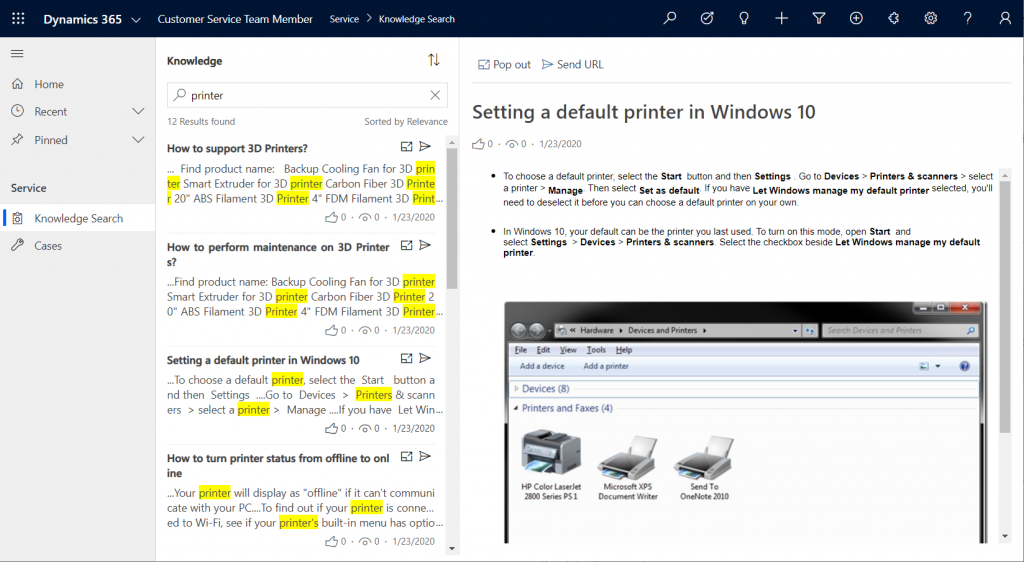
It’s good to keep in mind that certain features of Model-driven Apps in Dynamics 365 aren’t yet App Module aware – meaning they’ll be presented in the UI the same way regardless of which specific app the user has launched. Recent and Pinned items will contain data not included in the App Module, Advanced Find will show all entities that are visible to the user’s security role, the Assistant and (deprecated) Task Flow buttons will always be there in the top Nav Bar. Still, the core experience of App Modules can be restricted down to a limited subset of features, as demonstrated by these Team Member apps. When moving from legacy web client to Unified Interface, these type of targeted experiences definitely are something worth pursuing, rather than the oldskool CRM monoliths that contain a hundred and one items in the navigation.
Now that we know what comes out of the box for Team Member users, many customers will surely be asking what to do with the functionality in their CRM systems that isn’t represented in these standard App Modules. To understand the commercial boundaries better, let’s have a look at what the latest February 2020 licensing guide has to say about the rights of Team Members. We’ll start from Appendix A and the table that describes use rights for Team Members in Customer Engagement apps. (Yes, even though Microsoft product documentation says the term “Customer Engagement” is no longer used for online products, the licensing team hasn’t yet come up with a new term to replace CE in the licensing guide.)
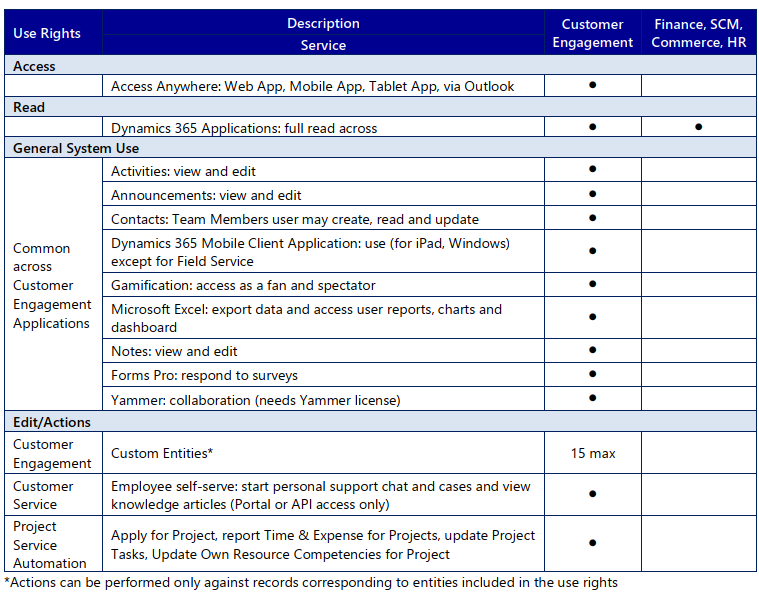
To start off, Team Members still have the right to read all Dynamics 365 application data. Therefore every single entity you could possibly include within the Sitemap of an App Module could in theory be brought in there. Of course you would have to ensure via the security roles that no creation or modification of those records would be allowed. Also the reporting and dashboards features are explicitly stated as being available for Team Members, on page 11 of the licensing guide.
As for custom entities, we see that there are also edit/actions rights, but we have a “15 max” restriction in the table. What does that mean? The answers are given in Appendix D: Custom Entities.
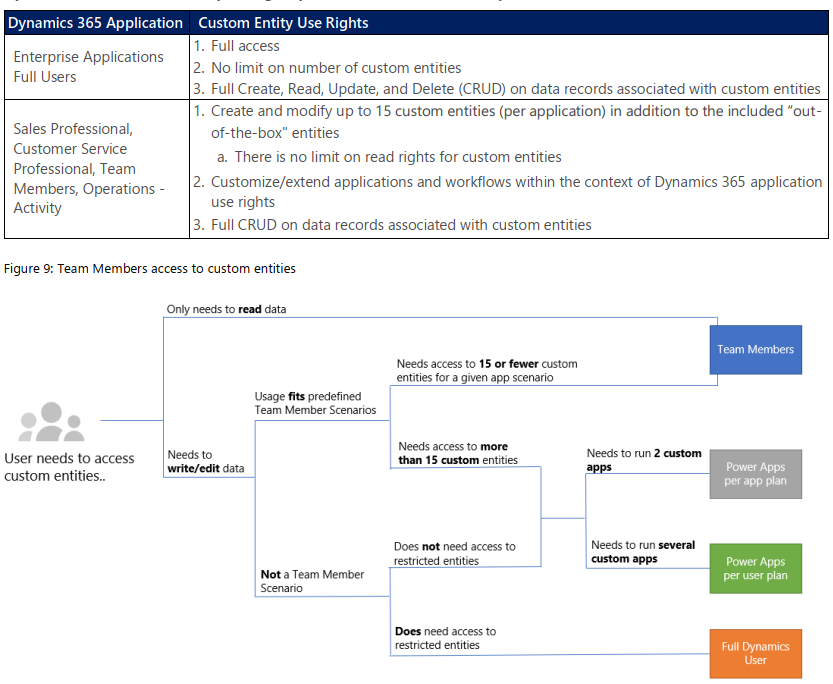
We see that for a given app scenario, Team Members can create and modify records for up to 15 custom entities – per app. Where the lines are a bit blurry is the statement that this usage should “fit predefined Team Member scenarios”. As long as these custom entities are related to sales or customer service processes, I guess you’re on the safe side to add them to the standard Team Member App Modules that soon will be the only way for users with Team Member licenses to access Dynamics 365 – once the enforcement for first-party vs. custom apps is enabled in April 2020. Again, keep in mind that read rights are included for any entity, so the 15 custom entity limit couldn’t ever be technically enforced on the App Module level, based on how I interpret the licensing terms.
What if you really need to do more than what the Team Member license would allow? What if you’re building apps for your unique business processes that aren’t covered by any first party app in the Dynamics 365 suite of products? Then you should explore the possibilities of Power Platform and its licensing model. Power Apps Per User Plan is the platform SKU that Team Member never was intended to be. If you’d map all the current and future workloads that Power Apps could take over in your organization’s business applications portfolio, the value is likely to be much higher than what the customization of these Team Member apps could ever deliver.
Read more
Microsoft has published new documentation on Dynamics 365 Team Members license that outlines the user experience for accessing the App Modules, as well as the customization restrictions.
It seems a loss in the rights to create activities in the grid above, or is that covered in the appendix B of the licensing document which is how it currently works, or is Appendix A eventually replacing Appendix B.
I have lots of users who only use Dynamics through the Outlook app to track emails; this would imply they would need a full license even though they never go to Dynamics through the browser.
Mark, I don’t think there has been any intentional change like that in the user rights. It’s just the ambiguous language that is unfortunately often used in documents like this that should be far more precise. Appendix B still says Team Members have Create/Update/Delete rights for activities, so I’d assume the use case for Outlook email tracking remains valid.
What if I need more than one Sales Team Member App because I want to give different user roles different apps (all with team member licenses)?
Can I create a own / new Team Member App for the second user role?
How can I switch license enforcement on in the sytem to test the behaviour before it gets standard?
Christian, my current assumption is that you can’t create new App Modules as those would be consider as custom apps. As for testing the licensing enforcement, I’ve heard that this capability has not yet been launched as part of the Early Access program, but Microsoft does plan to make it available for customers to enable in their organizations for validating how users will be impacted.
Hi Jukka, this is a great post that provides an excellent summary of the Dynamics 365/Power Apps licencing for the new Team Member Apps.
Once question that I have that I would really appreciate your thoughts on is using the Team Member Licence for accessing Dynamics data (CRUD on Lead) from a Canvas App. Our customers licencing partner has recommended a Team Member licence for such a scenario, however I am not sure that is correct.
thanks
Paul
Thanks, Paul! The advice from the licensing partner certainly isn’t correct, since Team Member license doesn’t grant you the right to A) create leads or B) run custom Canvas apps. So that’s the easy part.
Now, for the type of license that would be applicable here, the first option that I would investigate is the Power Apps Per App Plan at $10. With this you’d be able run max 2 Power Apps (Canvas or Model-driven) & access 1 Power Apps Portal within the same environment. Sounds like a pretty nice deal compared to Team Members, right?
The one potential issue with this is the list of restricted entities requiring Dynamics 365 license. Today, the lead entity is not there. However, on August 29 Microsoft posted on their Licensing News page that “select Dynamics 365 for Sales entities will be added to the restricted entities list on October 1st 2019”. Unfortunately the update for the restricted entities list has never materialized. This means that neither customers nor partners can know for sure what is the scope of entities in the Common Data Model that can & can’t be used with a Power Apps premium license.
Today, the way I interpret the rights of Power Apps licenses in a Dynamics 365 environment, CRUD for leads via Canvas app would be supported. That’s what I would go for, since it’s really the only sensible option for enabling a basic data management scenario like this that shouldn’t require a $95 Enterprise Sales App.
Jukka , Thanks for posting this.
I have 2 questions if you have time:
1. What is the cheapest licensing option for users who only need view access to D365 data but also need access to custom model-driven apps?
2. Will users still be able to access “Dynamics 365 App for Outlook” and track emails?
The guide says “Customer Service Team Member”, “Sales Team Member” and “Project Resource Hub” are the designated app modules. It doesn’t reference “Dynamics 365 App for Outlook”
Thanks,
Sean
Sean, the cheapest license for viewing Dynamics 365 data would be Power Apps Per App Plan, since even the restricted entity definition doesn’t restrict read operations: “If an app or flow only reads information from an entity, a Dynamics 365 license is not required and an appropriate Power Apps or Power Automate license is all that’s needed.”
As for Outlook, I believe that since this specific app doesn’t even show up in Home.dynamics.com list of apps, it’s treated as a special App Module that doesn’t fall into the first-party/custom categorization. The Dynamics 365 Licensing Guide states that Team Members have the right to “Access Anywhere: Web App, Mobile App, Tablet App, via Outlook”. I imagine nothing will therefore change when it comes to Team Members user experience with Dynamics 365 App for Outlook.
Thanks Jukka, yes the fact that MS have not updated the restricted entity list is a little frustrating, but you are correct in that we can only deal with the information that we currently have.
Thank you again
Paul
So, the Sales Team Member app role doesn’t let you create or edit Leads or Opportunities even if they are assigned to you by someone else? That really does make it pretty restrictive doesn’t it.
Pretty much all you can do is add notes/activities onto Accounts/Contacts/Leads/Opps.
I wonder what the rules are around custom entities triggering things for the Sales Team user. For example, a custom entity called new_LeadQualification is created in the environment where the team member has the rights to create a record with some details on it such as reason and date. This entity triggers a Flow which qualifies the lead. The Flow could have the privileges of a fully licences admin account.
Matt, what you’re talking about is multiplexing and Microsoft clearly states in their Licensing Guide that this doesn’t reduce the number of user subscription licenses needed.
Technically yes I know it’s multiplexing but Microsoft also realise that if they want companies to embrace the Business Applications potential of using small model/canvas driven apps for specific use cases alongside the enterprise apps they are going to have to either allow a bit of multiplexing or open up the restricted entities a bit. The way they might allow multiplexing is to rely on the API calls limits in place on individual users. Currently 20k a day if I recall. So if a single user is hammering the system in a scenario like above they can still get some revenue from it.
Hello Jukka,thank you for this post.
Are there any hints about how the license terms will be enforced after the rollout? Especially the limit on access to only 15 custom entites?
Thank you
Ondrej, the only documentation I have found is the one linked at the end of the article. In the App Module Designer there is a limitation on the number of entities you can add already, so you can test this with the Early Access version ahead of the official 2020 Wave 1 release.
Thanks for this Jukka, in one of your earlyer posts you wrote that embedded canvas apps (in modell-driven app) will be OK to use with Team Member license. Is this true now? Am I allowed to embedd a canvas app in one of those Team Member model-driven apps?
Thanks in advance
Zarko, there should be no changes to the use of embedded Canvas apps, since these have been within the scope of Team Member licenses already earlier. Standalone Canvas apps have not been permitted, and now with the new licensing enforcement mechanism this will be extended to the Model-driven apps App Modules. Customization of the standard App Modules is allowed, so including an embedded Canvas app on an entity form is considered to be within the scope of the Team Member license rights, as far as I’ve understood them.
Hi Jukka,
Thanks for this post ! I have a question : I activated the release wave1 on my test environment but I still don’t see the “Sales team member app”. I have a user with TM licence. Do you have any idea why it doesn’t work ?
Thanks in advance,
Mo
Mo, do you have the Sales Hub app installed, as indicated in the documentation as a prerequisite for the Sales Team Member app to show up? In the 2 test environments I’ve used for 2020 Wave 1 early access the Sales Team Member app did appear automatically – unlike the Customer Service Team Member App that requires separate installation (and a support ticket in my case).
Hey Jukka,
I have been creating custom entities and app for my organisation for quite some time. The two most necessary and important apps utilises the cases and appointment entities respectively ( along with a few other support entities ).
does this license plan mean i have to purchase the full customer service enterprise plan for all of my staff members ?
Thanks
Kale, if your Team Member licenses have been acquired through an agreement that already applies the October 2018 then they have never granted you rights to create, edit or delete case records – outside the self service scenarios. Since the case (incident) entity is a restricted entity, you also can’t leverage any Power Apps plans for create-edit-delete functionality. Depending on how much of the service features you’re using, you could use either the Customer Service App or Sales App, where the latter one provides more limited features. Both also have the choice between cheaper Professional license instead of Enterprise license, but be aware that there is also a similar 15 custom entity limitation with the Professional plans as there is with the Team Member. Please study the detailed features available for each plan in the Dynamics 365 Licensing Guide, Appendix B: Customer Engagement Applications Use.
Rights
Problem fixed (You’re right) ! Do you think that clients that still are in legacy web client will be affected by this change in april ?
That seems unlikely to me… because it meens that some users will use the UI and others the Web client :S
Mo, the enforcement only applies to Unified Interface App Modules. After October 2020, every customer will only have these apps available as the legacy web client is removed, so at that point the Team Member licensing enforcement will also be “unified”.
Hi Jukka an excellent summary (as ever),
One thing I noticed is that (so far) I’ve only seen reference to “accessing” **user** reports, charts and dashboards not **system** ones and “create and update” & “customize” **system** reports, charts and dashboards not **user** ones. Is that just oversight/omission do you think or can Team Members only use **user** ones.
Simon, I believe it’s just an oversight, since it’s hard to see the point of creating such a limitation and forcing people to share personal charts/dashboards instead of directly using system ones.
I also notice that “Access Anywhere” does NOT include offline access (p26)
Hi Jukka
We have built our own management system that uses contacts and organisations but also other custom entities built when CRM had the XRM sales pitch. We are now assuming that we don’t meet this vaguely described ‘predefined scenarios’ requirement – and feel somewhat let down by his licensing change….
Also I note that the sales team member security role you show above has only read and append to for the contact entity whereas appendix A of the latest licensing guide says ‘contacts: team members user may create, read and update’ and appendix B says: ‘entities: create , update, delete: has a dot against contacts for sales / team members. Any ideas why the discrepency?
Thanks
David, please see Q3 and Q4 in my blog post Dynamics 365 & Power Platform licensing FAQ, February 2020.
Hi Jukka
Thanks for the reply. The Microsoft answer to Q3 is still obscure – can I modify the Sales app with custom entities so that the user is no longer using CRM with a sales hat on and still use a sales team member license?
Also the 15 entity limit is confusing – I understand it to be write rights to 15 custom entities and read rights to unlimited custom entities (that are e.g. used as read only lookup fields e.g. country: France)
Dynamics 365 – Understanding The Teams Member Licence Restrictions
Photo by Pixabay from Pexels The art of simplicity is a puzzle of complexity. Douglas Horton
Thx for sharing. I try to find the defintion of a embedded canvas app. Is it an app that is embedded within the context of a form/record or can it be a canvas app linked from the sitemap/left menu in a Model Driven app? (yes, I know about custom pages, but for mye use case I need to use a Canvas App)
Pål-André, the scenario of embedded Canvas apps within Model-driven apps is specific to forms. You can read the documentation of what can & can’t be done on this Docs page. These apps would work in the context of a single record and are therefore more limited than simply linking a full Canvas app to the sitemap. I wouldn’t imagine the latter being supported without a Power Apps premium licenses or Dynamics 365 Enterprise license.